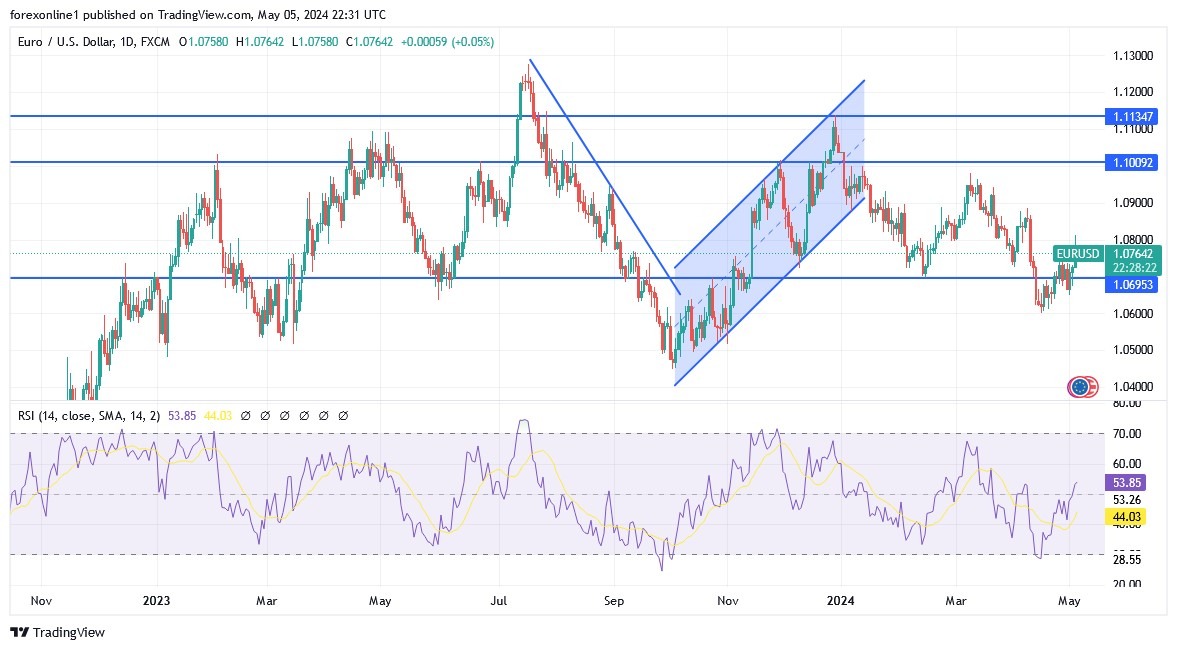EUR/USD Analysis: After US Jobs Numbers
As seen by markets and analysts, there were signs that the Fed and the ECB would diverge this year. The Fed signalled in its statement last week that the US economy remains strong due to strong consumer spending. It also remained silent on when it would start cutting interest rates. As a result, economists have mixed views on when rate cuts will start. Some believe they will start later this year, while others expect them to come in 2024 as inflation remains stubbornly high.
According to economic calendar announcements, the Consumer Price Index (CPI) rose to 3.5% in March, while Personal Consumption Expenditures (PCE) rose to 2.5%. These numbers mean that inflation has stopped falling and it could take longer to reach the Fed's 2% target. Consequently, some analysts believe the Fed's stance is wrong as the economy is showing some signs of stress. For example, while consumer spending is holding up, it has been supported by borrowing. Moreover, the latest data shows that credit card debt has risen to $1.7 trillion. Also, household debt has risen to $17.5 trillion, while delinquency rates are rising.
On the other hand, the European Central Bank is committed to starting to cut interest rates in June. Europe's inflation rate fell to 2.4%, and lower energy costs are likely to push it to the 2% target soon. Likewise, manufacturing activity in the bloc is shrinking while most consumers suffer. Therefore, in the near term, there is a possibility that the carry trade opportunity will lead to a stronger US dollar and a weaker euro.
The non-farm payrolls report was released on Friday, with stock markets holding well within the FOMC range, while the dollar traded at its lowest level since April 11. The expectations for some of the readings were somewhat average, with average hourly earnings and the unemployment rate expected to remain unchanged, and a headline reading of +238k. However, the readings were significantly weaker, missing all estimates – the headline number was just +175k, the unemployment rate rose to 3.9%, while average hourly earnings rose by 0.2%. Overall, none of these numbers are terrible – in fact, the labor market still looks healthy – but these misses should be taken in the context of the FOMC meeting where the Fed maintained a dovish tone despite rising inflation. As ING pointed out, they have a bias towards easing. So, this jobs report could help them justify cuts.
Overall, the cautious repricing has created a logical response in most markets – US stocks are up over 1%. Ultimately, the dollar has fallen sharply and tested its 50-day moving average, while bond yields have fallen.
EUR/USD Technical analysis and forecast:
The price of the EUR/USD pair has remained stable over the recent period with an upward bias partly due to the moderate dovish policy of the US Federal Reserve. Clearly, it remained steady above the key support level at 1.0700. Also, the pair formed a small ascending channel, which resembles a bearish flag pattern. Furthermore, the EUR/USD pair moved below the 50-day moving average. Technically, it moved slightly above the key support level at 1.0697, its swing low on February 14. Therefore, the outlook for the pair is bearish. Unless the bulls succeed in moving strongly towards the resistance levels of 1.0830 and 1.1000, respectively, the most prominent areas on the daily chart above to confirm the change in trend.
More By This Author:
EUR/USD Analysis: Weak Bounce Despite Fed AnnouncementEUR/USD Analysis: Bulls Await More Stimulus
EUR/USD Analysis: Rangebound Trading Ahead Of Key Events
Disclosure: DailyForex will not be held liable for any loss or damage resulting from reliance on the information contained within this website including market news, analysis, trading signals ...
more



